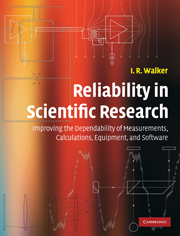 Reliability in Scientific Research
Reliability in Scientific Research Book contents
- Frontmatter
- Contents
- Preface
- List of abbreviations
- 1 Basic principles of reliability, human error, and other general issues
- 2 Mathematical calculations
- 3 Basic issues concerning hardware systems
- 4 Obtaining items from commercial sources
- 5 General points regarding the design and construction of apparatus
- 6 Vacuum-system leaks and related problems
- 7 Vacuum pumps and gauges, and other vacuum-system concerns
- 8 Mechanical devices and systems
- 9 Cryogenic systems
- 10 Visible and near-visible optics
- 11 Electronic systems
- 12 Interconnecting, wiring, and cabling for electronics
- 13 Computer hardware and software, and stored information
- 14 Experimental method
- Index
- References
2 - Mathematical calculations
Published online by Cambridge University Press: 05 June 2012
- Frontmatter
- Contents
- Preface
- List of abbreviations
- 1 Basic principles of reliability, human error, and other general issues
- 2 Mathematical calculations
- 3 Basic issues concerning hardware systems
- 4 Obtaining items from commercial sources
- 5 General points regarding the design and construction of apparatus
- 6 Vacuum-system leaks and related problems
- 7 Vacuum pumps and gauges, and other vacuum-system concerns
- 8 Mechanical devices and systems
- 9 Cryogenic systems
- 10 Visible and near-visible optics
- 11 Electronic systems
- 12 Interconnecting, wiring, and cabling for electronics
- 13 Computer hardware and software, and stored information
- 14 Experimental method
- Index
- References
Summary
Introduction
In books on mathematical methods in physics, there is a very frequent tendency to ignore the subject of errors, and what can be done to prevent them. In conversations on this topic, two common points of view are: (1) error prevention is an ability that is acquired through practice (i.e. it is not something that is taught explicitly), and (2) one just has to be careful. While both viewpoints contain elements of truth, it is also true that techniques exist for preventing and detecting errors. Furthermore, these can be passed on explicitly like other skills (i.e. they do not have to be learned through hard experience.) Such techniques are the subject of the present chapter. These are mostly concerned with the prevention of errors in symbolic (i.e. algebraic) calculations, rather than numerical ones, unless otherwise indicated.
Sources and kinds of error
Conceptual problems
The first and most subtle types of error in analysis in general arise from conceptual problems: understanding the essential physics of a problem and expressing it in mathematical form.
Transcription errors
A second very common type, frequently encountered when calculations are done by hand, is transcription errors. These occur when formulae and numbers are copied from one line in the calculation to the next, often taking place when the handwriting is untidy and cramped. They also arise very frequently if more than one mathematical operation is attempted per line in the calculation.
- Type
- Chapter
- Information
- Reliability in Scientific ResearchImproving the Dependability of Measurements, Calculations, Equipment, and Software, pp. 36 - 57Publisher: Cambridge University PressPrint publication year: 2011


